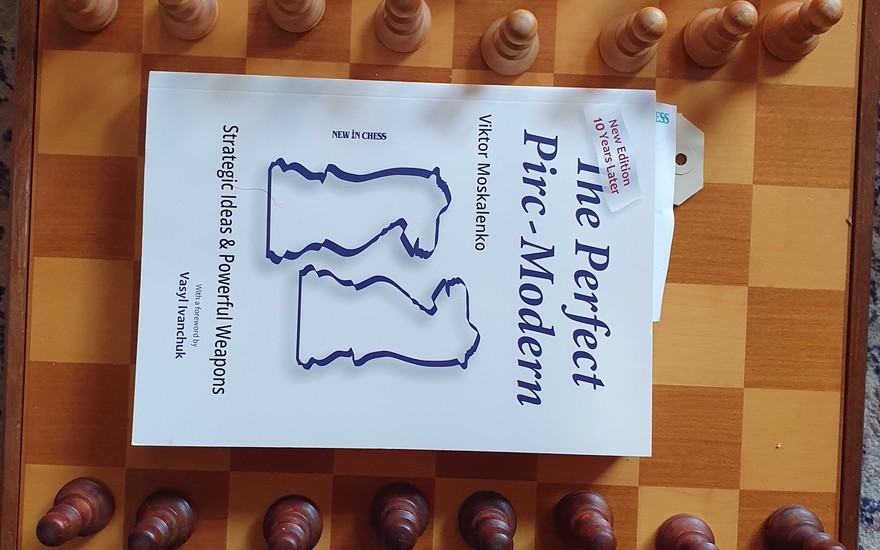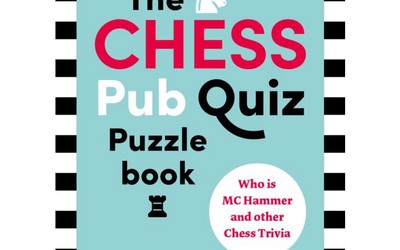
Review: The Perfect Pirc-Modern by Viktor Moskalenko
This is a review by FM James Vigus of Moskalenko's The Perfect Pirc-ModernThe Perfect Pirc-Modern
by Viktor Moskalenko
New in Chess 2023, paperback, 255 pages
Sample material available on the publisher's website
Contents:
6 Explanation of symbols
7 The Perfect Pirc-Modern - ten years later
8 Foreword by Vasyl Ivanchuk
9 Introduction
12 Seven symbols
13 Chapter 1 - The Austrian Attack: Introduction [1 e4 d6 2 d4 Nf6 3 Nc3 g6 4 f4 Bg7]
21 Chapter 2 - The Austrian Attack with 5. ..c5 [after 5 Nf3]
54 Chapter 3 - The Austrian Attack with 5. ..0-0 [after 5 Nf3]
117 Chapter 4 - The flexible move 4.Be3
168 Chapter 5 - The dynamic bishop attack 4.Bg5
197 Chapter 6 - White ́s fianchetto: 4.g3
211 Chapter 7 - The classical 4.Nf3
225 Chapter 8 - Anti-Pirc systems - Miscellaneous Ideas
243 Index of variations
247 Index of names
254 Bibliography
255 A brief biography
Subtitled 'Strategic Ideas & Powerful Weapons', this book is primarily on the Pirc Defence, 1 e4 d6 2 d4 Nf6 3 Nc3 g6, with a few bonus games on Modern move-orders (1...g6). A couple of White's third-move alternatives (3 Bd3, 3 Nd2) are briefly covered (though not 3 f3). The book consists of 42 annotated games, annotated in a lively way with many text boxes set off from the main text offering 'weapons', 'puzzles', 'tricks' and so on - similar in this respect to the format of some Everyman opening books.
As usual with the Ukrainian GM's popular opening books, the work recommends a sharp opening to players of one particular colour. In other words, it is aimed firmly at those who wish to play this opening with Black (at any level). It is not a repertoire book, however: Moskalenko offers multiple alternatives in the main lines. This is definitely a good decision. It's crucial for a Pirc player to cultivate flexibility and avoid becoming an easy target for an opponent's preparation.
This is a new edition of a book first published ten years ago, in 2013. Perhaps the first question that arises is whether it is worthwhile for an owner of the 2013 volume to purchase this overhaul. 33 of the 42 main games are new, and all are packed with post-2013 references, so I would indeed recommend the fresh purchase in this case.
Usually I tend to worry about whether I am adequately qualified to make judgments about chess books, especially books about openings in which I have little personal experience. However, I've published two books on the Pirc myself (The Pirc in Black and White, 2007 and Chess Developments: The Pirc, 2012) and collaborated on a third (Dangerous Weapons: The Pirc and Modern, 2009, all with Everyman Chess). So I am happy to say with more than usual authority that Moskalenko's new book is the best, most up-to-date choice for anyone who wishes to try the opening. Since Moskalenko's 2013 edition I'm only aware of one book exclusively on the Pirc, GM Mihail Marin's The Pirc Defence (Quality Chess, 2017); and another that incorporates a Pirc repertoire, GM Alexei Kornev's A Practical Black Repertoire volume 1 (Chess Stars, 2016).
I have not studied Marin's work in detail, but my impression is that there is relatively little overlap between Marin and Moskalenko. Another disclaimer: various online Pirc courses are now available, including Damian Lemos's and Marcin Sieciechowitz's for Modern Chess and one by Christof Sielecki and Michael Gorny for Chessable. I haven't read these so I can't compare them.
Moskalenko is generally thorough; he also includes quite a bit of new analysis, including of some of his own games.
The Pirc seems to be in very decent shape theoretically, just as it was a little over a decade ago when I wrote my last book. Moskalenko generally chooses sharp lines, and this material will surely appeal to players who want a sound yet combative option against 1 e4 that is not excessively theory-heavy. There is one arguable drawback to the Pirc by comparison with the defences popular at the top level (Berlin Defence, Petroff, Sicilian Najdorf, French Defence, etc.), which is that by refraining from occupying the centre immediately Black allows the opponent a wide range of options. Little moves like h3 or a3 by White can make a surprisingly large difference to the problems we have to solve as Black; systems like 4 Be3 and 4 Bg5 can be annoying in subtly different ways. Subjectively speaking, I've also had the frustrating experience of struggling to make headway against a lower-rated White player with much less knowledge of the opening than I have, just because early in the game White has so many intuitively reasonable moves available. These are typical examples of the awkwardness that can be involved in playing a 'second tier' opening (one that is a little less engine-approved than those named above). That said, one simply can't have everything. I still consider the Pirc a practical and enjoyable counter to 1 e4, and Moskalenko is now the reference work I consult first. Having the Pirc in your armory against 1 e4 also provides fresh flexibility against 1 d4: for example, I used to play the Leningrad Dutch with the move-orders 1 d4 d6 2 c4 f5 or 2 Nf3 g6 3 c4 f5; or tricky lines like 1 d4 Nf6 2 Nf3 g6 3 Nc3 can be met with 3...Bg7 allowing 4 e4.
The presentation of Moskalenko's book is generally engaging, with plentiful diagrams; the typo in the running header of chapter 4 (4 Re3 instead of 4 Be3) is a rare blemish. It is not easy for a writer on the Pirc to decide which lines to prioritize in order to achieve a good balance of material, but I feel that Moskalenko has managed this well.
Moskalenko's book is of course engine-checked throughout (Stockfish is mentioned in the relatively thorough bibliography), but it remains on the level of traditional opening analysis, with game fragments and indicative evaluations. I confess that it took me some time to summon up the courage to read The Perfect Pirc-Modern. Given the engine revolution of the past seven years or so, which coincided with my total break from chess, I thought I might find my 'old' analysis constantly overturned on every page. Unsurprisingly, I did indeed make some mistakes which are corrected in Moskalenko's book. On closer inspection, however, the situation is by no means as radical as I'd anticipated. Swathes of Pirc theory have changed little in the past 10 or 15 years. What this means is that no-one (Moskalenko included) has yet published heavy new analysis of this opening using the modern super-engines...
...Except that now, all of a sudden, the Pirc is receiving the Matthew Sadler treatment: search for 'Pirc' here and click through for the associated pgn game files and youtube videos. I can hardly resist commenting further on this, so I intend to write some more on Moskalenko and Sadler's Pirc analyses in separate posts.
More blog posts by Minckwitz

Review: Some instructional and training works
Review by FM James Vigus of recent training/calculation books
Review: Basman's Folly (1 g4) by Lakdawala and Hansen
Review by FM James Vigus of Lakdawala & Hansen's book on the Grob
Review: The Hungarian Dragon by Junior Tay
A review by FM James Vigus of Junior Tay's 'The Hungarian Dragon'